
In my last post, 8 Kanban Board Templates for Agile Marketing, I discussed several common marketing functions — content marketing, demand generation, marketing operations, product marketing, events, and PR and social media – and provided Kanban board templates from Planview AgilePlace™ to help marketing teams and their stakeholders plan, track, and manage their work more effectively.
In this post, I want to provide advanced Kanban board templates for high-level boards in Planview AgilePlace that allow campaign managers to see the entirety of marketing initiatives and to drill down to the status of individual deliverables. I’ll also show you how to create boards that demonstrate how tactics relate to strategy and allow CMOs and other senior leaders to see a high-level view of execution of strategic initiatives.
Campaign Management
Marketing campaigns require the coordination of multiple deliverables, typically generated by multiple groups. For example, the promotion of a gated eBook — where the customer gets valuable content in exchange for their email — might require the work of:
- writers and graphic designers who generate the eBook
- web developers and graphic designers who develop a landing page sequence for collecting and confirming the email address
- email marketers who promote the eBook
- social media managers who also promote the eBook
- search engine marketers who promote the eBook in relevant searches
- advertising campaign specialists who promote the eBook through sites like LinkedIn, Facebook
The campaign manager must track the status of all these activities, ideally from a single board. This is a perfect case for the use of parent-child relationships, which is illustrated by Figures 1-4.

In Figure 1, we see a parent card, “The Ultimate Guide to Kanban board design for Agile Marketing.” Visually, we can see that it is due Aug. 20, and it has seven child cards, two of which are finished. The yellow caution sign indicates that something isn’t on track.
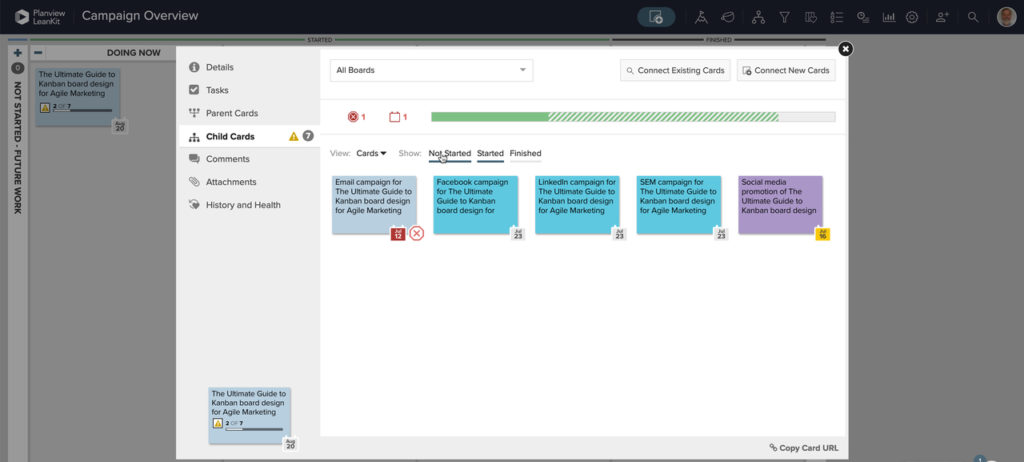
By clicking on the parent card, we can see the child cards, as shown in Figure 2. By default, we see only the cards that are not started or started but not yet finished. If we want to see the finished cards, we can do that by clicking on the finished tab, as shown in Figure 3.
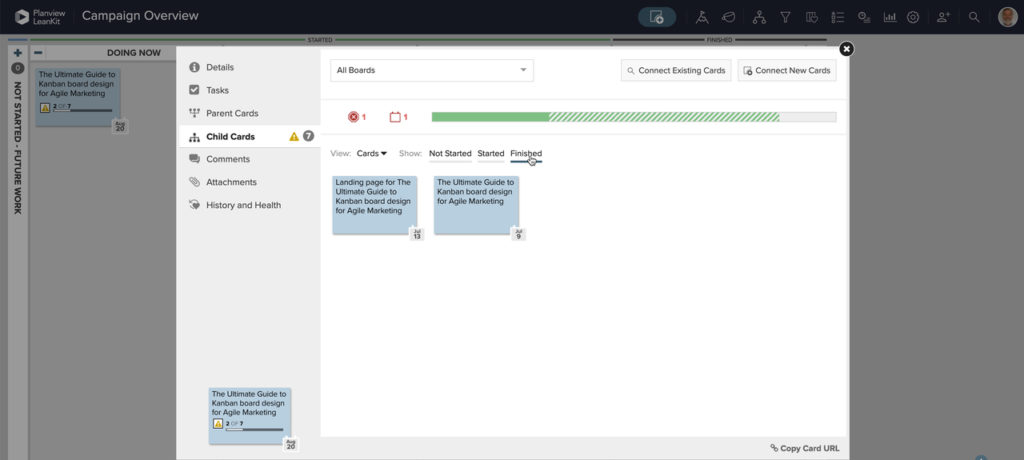
In Figure 3, we see that we’ve completed writing the guide and creating the landing page. But going back to Figure 2, we see that we have one card that is overdue and blocked: the email campaign. We can click on this card to see (in Figure 4) that the email campaign is blocked because some assets from the graphic designers have yet to be delivered.

Child cards can have their own child cards to represent second-level dependencies. For example, this email campaign, which is a child card of the Ultimate Guide campaign, has a child card for its graphic assets. It is that card that we are waiting on.
The whole system of parent-child card relationships is quite intuitive and is useful to represent the real world of marketing, where campaigns have dependencies and some of those tasks have further dependencies. The ability to quickly drill down on child cards allows us to identify and presumably fix issues quickly.
Visualizing Strategies and Tactics
Let’s take a look at the second challenge I posed at the beginning of this post: how to create boards that show how tactics relate to strategy, allowing CMOs and other senior leaders to see a high-level view of execution of strategic initiatives.
Let’s say a business has three key strategic initiatives:
- Innovation: 40% of overall revenue comes from products that are fewer than five years old
- Operational and Customer Service Excellence: Net Promoter Score (NPS) of 70 or above
- Employee Satisfaction: employee turnover rate of less than 8% per year and receiving workplace awards such as the Fortune 100 Best Companies to Work For® list.
The business has funded a portfolio of programs for each of these strategic initiatives, and in turn, each of these programs has multiple projects, usually assigned to a department, for execution. Within the department (marketing, for example), multiple teams may work on multiple deliverables for the project.
These programs, projects, and deliverables are represented by three levels of boards: Portfolio (which tracks the programs), Projects, and Teams (which track the individual deliverables). Figure 5 shows an example of a portfolio-level board that allows everyone to visualize all the major programs that contribute to the three major strategic initiatives.
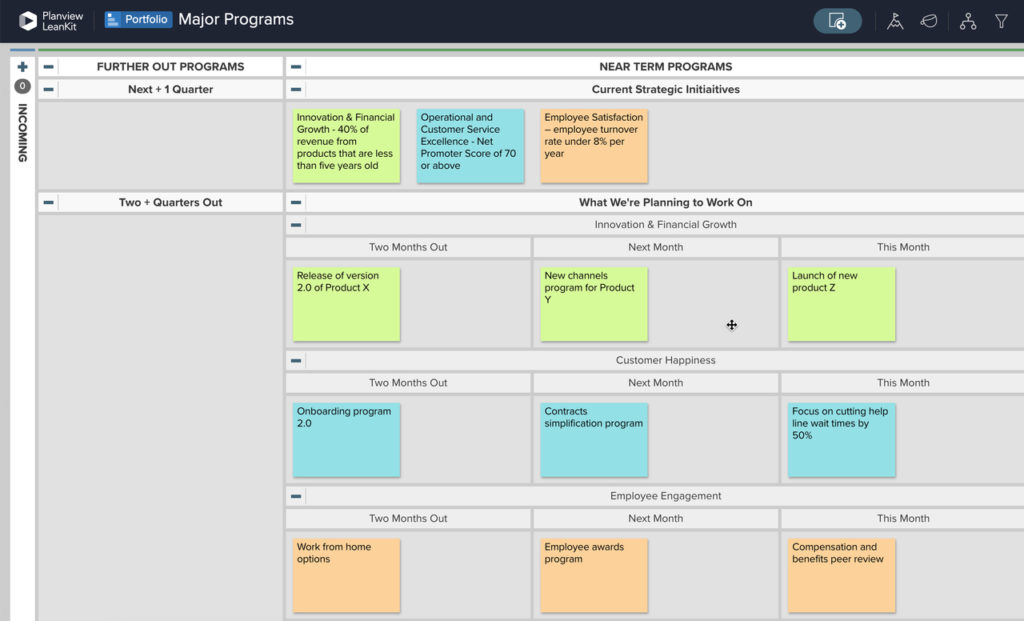
Also in Figure 5, note the use of the swimlane for listing the major initiatives. These cards don’t move. They are there simply to remind everyone of the major initiatives, as well as to subtly indicate the color coding used to indicate which program feeds into which initiative.
Here are more details about using board levels in Planview AgilePlace. By default, you have three levels: Portfolio, Projects, and Team. You can rename these levels to anything that works for you. You can also add another level (up to 4 total levels), as well as reorder them. For example, maybe you want to add a campaign-level board between projects and team board levels. See figure 6 for an example of how this is accomplished.
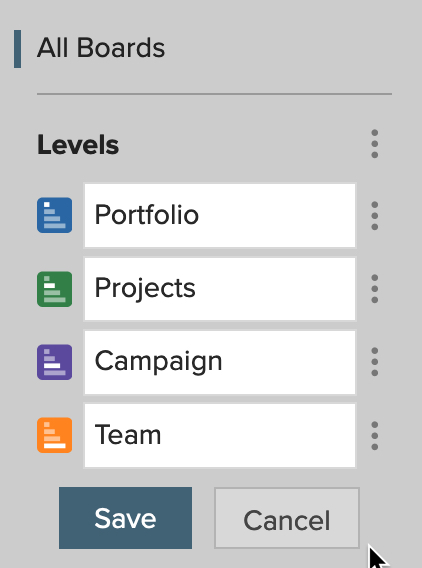
If needed or desired, each of these programs can be connected to child cards in the projects board, and each project can be connected to child cards in the team boards. This provides the ability to drill down from any program to examine the status of individual projects, and in turn, drill down to individual deliverables on a team board.
There is one other advanced feature of Planview AgilePlace that can help leaders tie tactics to objectives. Planview AgilePlace supports visualization of OKRs. If you’re not familiar with OKRs, the acronym stands for Objectives and Key Results. The concept was developed by Andy Grove at Intel and popularized by John Doerr at many Silicon Valley firms, most prominently at Google. Every objective has three to five key results, which are specific and measurable to indicate whether you are hitting that objective.
Objectives and key results can be defined for any board. Individual tasks or cards can also be tied to key results as activities. Let’s look at Figure 7 for an example of OKRs at work on a Planview AgilePlace board.
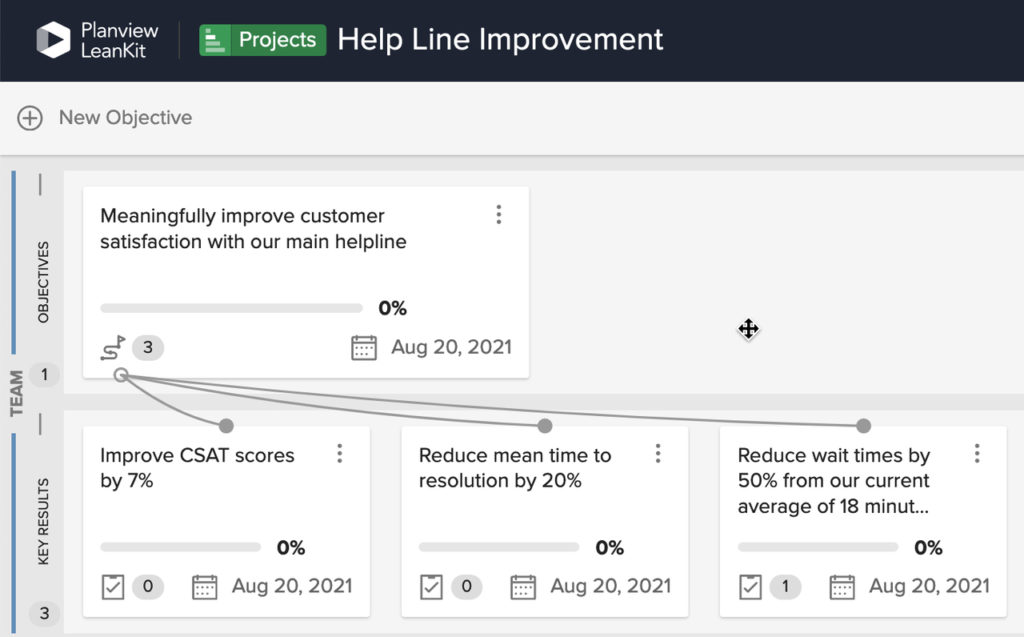
The board is called Help Line Improvement. Our objective is to meaningfully improve customer satisfaction with our main helpline, and we have three key results associated with this objective:
- Improving CSAT scores from the current 68% to 75%
- Reducing the mean time to resolving a customer’s issue by 20%
- Reducing wait times by 50%
In figure 8, we see an activity — “hire and train 50 new helpline staff by August 1” — tied to the key result of reducing wait times. We can add more activities here or add activities to the other key results.
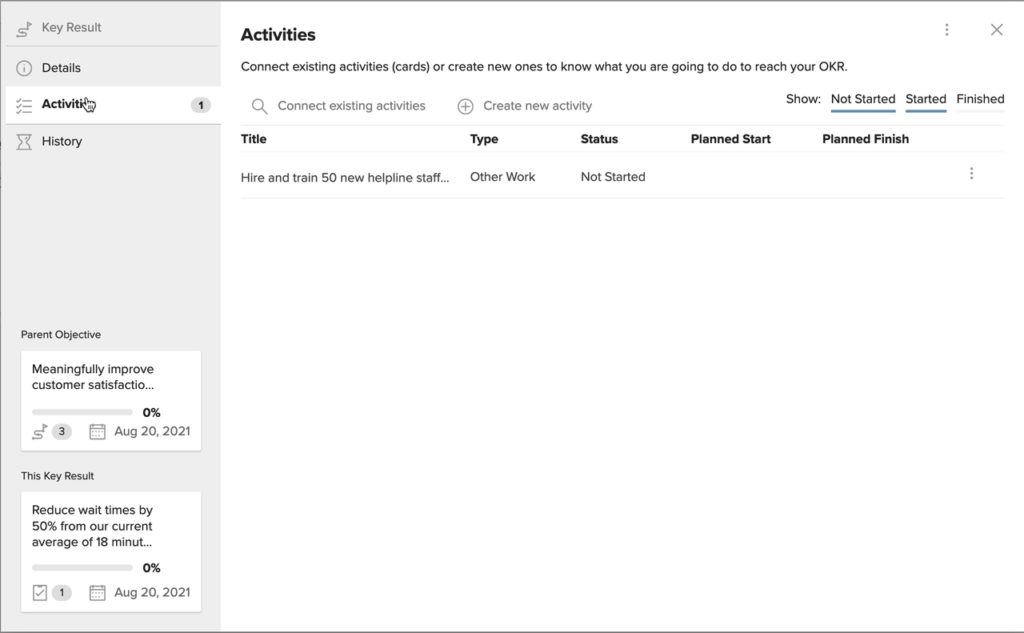
Bringing It All Together
Enterprise Kanban software solutions like Planview AgilePlace have one major advantage over ticket-based tools: Kanban software represents information visually. This is particularly helpful for visualizing the task dependencies for campaigns, as well as in tying tactics to strategy, and activities to objectives and key results.
Editor’s Note: As a reminder, Jim is offering the Planview AgilePlace board templates featured in his first post – all eight of them! — as a free download on his website. The templates are easy to upload and use. If you’re not a Planview AgilePlace customer yet, then you can try Planview AgilePlace free for 30 days. Consider using one or more of these Kanban board templates for Agile marketing in your trial so you can get started right away with a board that matches your process.

![2020: A Turning Point for Agile in Marketing [New Research]](https://blog.planview.com/wp-content/uploads/2020/04/iStock-1086831852-1024x576.jpeg)


